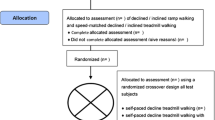Abstract
Background
It is difficult to identify objective parameters for assessing the joint function when dealing with the evaluation of orthopaedic procedures, especially endoprosthetic hip replacement. Clinical gait analysis enables parameters of force and movement to be quantified. However, the influence of gait speed on these parameters has hardly been taken into consideration so far. The objective of the present study was therefore to investigate the effect of gait speed on gait parameters and to simplify the clinical conditions in patients with osteoarthritis of the hip by determining a standardised gait speed.
Methods
A total of 28 patients with severe unilateral osteoarthritis of the hip were investigated at different gait speeds. The gait analysis equipment used consisted of an infinitely adjustable treadmill with force plates and an infrared video system. A special control mechanism permitted adjustment of the treadmill speed to a patient's self-determined pace.
Results
The mean gait speed of all patients with osteoarthritis of the hip was set at 2.20 km/h (0.61 m/s). Eight of the 10 gait parameters assessed increased significantly with changing gait speed. Pathological changes in gait patterns were found at the three gait speeds investigated, with the changes more accentuated at higher speeds.
Conclusions
Dependence of gait parameters on gait speed could be concluded for a group of patients and for control subjects. Use of a force-instrumented treadmill is necessary for the setting of a standard gait speed, which should be set as high as achievable by patients without inducing pain and problems of coordination or balance. With the usage of standardised speeds, clinical gait analysis becomes easier to perform. Furthermore, one can assess the expected biomechanical advantages of newer prostheses, thus providing the surgeon with a basis for further decisions.
Similar content being viewed by others
References
Alton F, Baldey L, Caplan S, Morrissey MC (1998) A kinematic comparison of overground and treadmill walking. Clin Biomech 13:434–440
Andersson GBJ, Andriacchi TP, Galante JO (1981) Correlations between changes in gait and in clinical status after knee arthroplasty. Acta Orthop Scand 52:569–573
Berman AT, Quinn RH, Zarro VJ (1991) Quantitative gait analysis in unilateral and bilateral total hip replacement. Arch Phys Med Rehab 72:190–194
Chao EY, Laughman RK, Schneider E, Staffer RN (1983) Normative data of the knee joint motion and ground reaction forces in adult level walking. J Biomech 16:219–233
Elliot BC, Blanksby BA (1976) A cinematographic analysis of overground and treadmill running by males and females. Med Sci Sport 8:84–88
Försterling L, Tscheuner R (1995) Symmetrievergleich des Ganges—eine Methode für die Beurteilung der prothetischen Versorgung. Orthop Technik 9:753–756
Groh H, Baumann W (1968) Kinematische Bewegungsanalyse. In: Biomechanics. Karger, Basel, pp 23–32
Hatanaka Y, Takai S, Hase H, Kubo S, Hirasawa Y (1994) Kinematic gait analysis of patients after total knee arthroplasty. In: Hirasawa Y, Sledge CB, Woo SLY (eds) Clinical biomechanics and related research. Springer, Berlin Heidelberg New York, pp 401–411
Kadaba MP, Ramakrishnan HK, Wootten ME (1990) Measurement of lower extremity kinematics during level walking. J Orthop Res 8:383–392
Krämer KL, Maichl FP (1993) Scores, Bewertungsschemata und Klassifikationen in Orthopädie und Traumatologie. Thieme, Stuttgart, pp 190–191, 219
Kroll MA, Otis JC, Sculco TP, Lee AC, Paget SA, Bruckenstein R, Jensen DA (1989) The relationship of stride characteristics to pain before and after total knee arthroplasty. Clin Orthop 239:191–195
Kyriazis V, Rigas C (2002) Temporal gait analysis of hip osteoarthritic patients operated with cementless hip replacement. Clin Biomech 17:318–321
Mainka C, Boenick U (1994) Integrierte Gangbildanalyse mit Hilfe eines Laufbandergometers. Orthop Technik 7:682–689
Murray MP, Drought AB, Kory RC (1964) Walking patterns of normal men. J Bone Joint Surg 46A:335–359
Murray MP, Gore DR, Clarkson BH (1971) Walking patterns of patients with unilateral hip pain due to osteoarthritis and avascular necrosis. J Bone Joint Surg Am 53:259–273
Perka C, Möckel G, Boenick U (2000) Kinetische und kinematische Ganganalyse vor und nach Knietotalendoprothesenimplantation. Z Orthop 3:191–196
Rösler J, Perka C (2000) The effect of anatomical positional relationships on kinetic parameters after total hip replacement. Int Orthop 24:23–27
Wall JC, Charteris J (1981) A kinematic study of long-term habituation to treadmill walking. Ergonomics 24:531–542
White SC, Yack HJ, Tucker CA, Lin HY (1998) Comparison of vertical ground reaction forces during overground and treadmill walking. Med Sci Sports Exerc 30:1537–1542
Acknowledgements
We are indebted to Prof. U. Boenick of the Technische Universität of Berlin for providing access to the gait laboratory and assistance in data evaluation. Furthermore, we wish to thank Devakara Epari of the Research Laboratory at the Clinic of Trauma and Reconstructive Surgery, Charité Berlin, for giving support both in data evaluation and setting up the English version of the manuscript. The experiments and clinical investigations comply with the current German laws.
Author information
Authors and Affiliations
Corresponding author
Rights and permissions
About this article
Cite this article
Möckel, G., Perka, C., Labs, K. et al. The influence of walking speed on kinetic and kinematic parameters in patients with osteoarthritis of the hip using a force-instrumented treadmill and standardised gait speeds. Arch Orthop Trauma Surg 123, 278–282 (2003). https://doi.org/10.1007/s00402-003-0513-0
Received:
Published:
Issue Date:
DOI: https://doi.org/10.1007/s00402-003-0513-0




